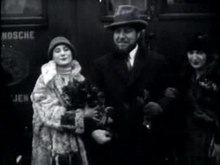Anna Pavlovna Pavlova
Anna Pavlova ( Анна Павловна Павлова , actually Russian Анна Матвеевна Павлова Anna Pavlova Matveyevna, in Western languages often Anna Pavlova transcribed ; born January 31, jul. / 12. February 1881 greg. In Saint Petersburg , † 23 January 1931 in The Hague ) was a Russian master dancer of classical ballet .
Life
Anna Pavlova attended the Petersburg theater school, where she was a student of Ekaterina Wasem , among other things . From 1899 she was part of the ensemble of the Mariinsky Theater there . She danced leading roles in The Nutcracker , Raimonda , Giselle , La Bayadère , Paquita , La Fille du Pharaon , Harlequinade and others. She danced larger roles under Michel Fokine , among others. in Les Sylphides and Egyptian Nights . In 1907, Fokine staged the famous solo The dying swan for her .
Guest appearances from 1908 all over Europe made Pavlova internationally known. When Sergej Djagilew founded Les Ballets Russes in Paris in 1909 , Vaslav Nijinsky and Anna Pawlowa took on the leading roles. The Ballets Russes became one of the most famous and successful ballet companies of their time.
From 1910 Anna Pavlova lived permanently in London . On their subsequent tours they accompanied the Berlin society photographer Frieda Riess and the draftsman Ernst Oppler . She was friends with the sculptor Hugo Lederer in Berlin in the 1920s and created two small, full-length self-portraits in his studio and under his direction, which are preserved as porcelain figures in the Victoria and Albert Museum in London (Museum No. S 296-1978 and No. S 105-1994). On January 23, 1931, while on her farewell tour, she died of pneumonia in a room at the Hôtel des Indes in The Hague at the age of 49 . The urn with her ashes was buried in the Golders Green Crematorium in the London borough of Hampstead .
Usage of names
One of the most famous desserts in Australia and New Zealand is the pavlova , a cake made from meringue . That dessert was named in her honor after she made several guest appearances in both countries in 1926 and 1929. In which country the pastry was invented is a matter of dispute. The Oxford English Dictionary names New Zealand as the place of origin because that is where the oldest known recipe with this name appeared in 1927.
A portrait of Pavlova is depicted on a Russian silver coin from 1993.
A McDonnell Douglas MD-11 (built: August 31, 1995) of the Dutch airline KLM Royal Dutch Airlines with the aircraft registration PH-KCH bore her name.
The eponymous foal of the novel Pavlova or How to Smuggle a Donkey Halfway Around the World was named after Anna Pavlova because of its long legs. The central central belt asteroid (3055) Annapavlova is named after her.
literature
- Barbara Beck: The most famous women in world history: From the 18th century to today . Marix, Wiesbaden 2008, pp. 76-78, ISBN 978-3-86539-942-7 .
- Jan Grynimega: Anna Pavlova . In: Reclams Universum 43.1 (1927), pp. 348-349 (with 6 sketches by Walter Müller-Worpswede).
Movie
- The Dumb Girl of Portici , directed by Lois Weber, 1916
Web links
- Literature by and about Anna Pawlowna Pawlowa in the catalog of the German National Library
- Page about Anna Pawlowa at the German Dance Archive Cologne
- Biography , Neue Vision newspaper , January 20, 2011 (Russian)
- Pavlova News , Vossische Zeitung , morning edition, January 3, 1927, p. 3.
- Pictures by Anna Pawlowna Pawlowa In: Virtual History
Individual evidence
- ↑ Ekaterina Vazem , short bio on Oxford Reference (English; accessed on December 21, 2020)
- ↑ Hugo Lederer. Memories of Anna Pavlova. In: The dance. Monthly magazine for dance culture. Volume IV (1931), Volume 3, pp. 6-7.
- ↑ Anna Pawlowa, self-portrait in tutu . ( vam.ac.uk [accessed December 15, 2016]).
- ↑ Anna Pavlova as a dragonfly, figurine in porcelain . ( vam.ac.uk [accessed December 15, 2016]).
- ^ Alan Davidson : The Oxford Companion to Food. Oxford University Press, Oxford et al. 1999, ISBN 0-19-211579-0 , p. 584: Article Pavlova .
- ^ Lutz D. Schmadel : Dictionary of Minor Planet Names . Fifth Revised and Enlarged Edition. Ed .: Lutz D. Schmadel. 5th edition. Springer Verlag , Berlin , Heidelberg 2003, ISBN 978-3-540-29925-7 , pp. 186 (English, 992 pp., Link.springer.com [ONLINE; accessed on September 6, 2020] Original title: Dictionary of Minor Planet Names . First edition: Springer Verlag, Berlin, Heidelberg 1992): “1978 TR3. Discovered 1978 Oct. 4 by TM Smirnova at Nauchnyj. "
- ^ Lois Weber and The Dumb Girl of Portici. February 10, 2017, accessed December 3, 2020 .
| personal data | |
|---|---|
| SURNAME | Pavlova, Anna Pavlovna |
| ALTERNATIVE NAMES | Павлова, Анна Павловна; Павлова, Анна Матвеевна; Pavlova, Anna Matveyevna; Pavlova, Anna |
| SHORT DESCRIPTION | Russian master dancer of classical ballet |
| DATE OF BIRTH | February 12, 1881 |
| PLACE OF BIRTH | St. Petersburg |
| DATE OF DEATH | January 23, 1931 |
| Place of death | The hague |



